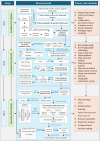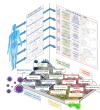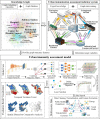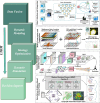Development of a data-driven urban immunity assessment model: providing a new benchmark for urban governance under public health emergencies
- PMID: 40510575
- PMCID: PMC12158983
- DOI: 10.3389/fpubh.2025.1609641
Development of a data-driven urban immunity assessment model: providing a new benchmark for urban governance under public health emergencies
Abstract
Public health emergencies (PHEs) pose significant challenges to global urban governance systems, necessitating the establishment of more efficient and dynamically adaptive response mechanisms. Numerous cases indicate that current urban governance still faces the risk of systemic failure under PHE shocks, leading to severe socio-economic consequences. Existing studies, based on theories such as resilience, emergency management, and risk management, primarily employ traditional statistical modeling or single-discipline approaches to explore improvement pathways. However, they fall short in cross-system and multi-agent coordination mechanisms, as well as data-driven intelligent optimization. Therefore, this project draws inspiration from the principles of the human immune system, introduces the concept of urban immunity to characterize the level of urban governance under PHEs, and follows the approach of "feature decoding → mechanism analysis → spatiotemporal measurement → trend prediction → model optimization → decision output." It refines the theoretical framework of urban immunity, analyzes urban immune response mechanisms, develops an immunity indicator system, assesses the spatiotemporal patterns of urban immunity, and builds a decision-making model using intelligent optimization methods to generate optimized solutions for different scenarios. Ultimately, the project aims to establish a data-driven, evidence-based decision-making approach. This project seeks to provide a more systematic and operational theoretical framework for urban public health governance while promoting the digital and intelligent transformation of public health management, thereby enhancing PHE prevention and control capabilities.
Keywords: assessment system; machine learning; optimization model; public health emergencies management; urban immunity.
Copyright © 2025 Cui, Cao, Qin and Zhang.
Conflict of interest statement
The authors declare that the research was conducted in the absence of any commercial or financial relationships that could be construed as a potential conflict of interest.
Figures
Similar articles
-
The analysis of urban collaborative governance in public health emergencies with fuzzy theory based on BP algorithm.Sci Rep. 2024 Dec 28;14(1):31427. doi: 10.1038/s41598-024-82966-8. Sci Rep. 2024. PMID: 39732906 Free PMC article.
-
How can digitalization be used to develop community resilience in public health emergencies?: A qualitative comparative analysis from China.PLoS One. 2024 Dec 23;19(12):e0315713. doi: 10.1371/journal.pone.0315713. eCollection 2024. PLoS One. 2024. PMID: 39715248 Free PMC article.
-
Investigation of the knowledge, attitude and behavior of medical personnel and related needs for emergency rescue in public health emergencies.Int Emerg Nurs. 2024 Dec;77:101531. doi: 10.1016/j.ienj.2024.101531. Epub 2024 Nov 5. Int Emerg Nurs. 2024. PMID: 39504817
-
Learning interventions in the WHO Eastern Mediterranean region: supporting Member States to get prepared for better response to health emergencies in the region.Front Public Health. 2024 Sep 12;12:1441223. doi: 10.3389/fpubh.2024.1441223. eCollection 2024. Front Public Health. 2024. PMID: 39329002 Free PMC article. Review.
-
Optimizing emergency response systems in urban health crises: A project management approach to public health preparedness and response.Medicine (Baltimore). 2025 Jan 17;104(3):e41279. doi: 10.1097/MD.0000000000041279. Medicine (Baltimore). 2025. PMID: 39833043 Free PMC article. Review.
References
-
- Li W, Yuan J, Ji C, Wei S, Li Q. Agent-based simulation model for investigating the evolution of social risk in infrastructure projects in China: a social network perspective. Sustain Cities Soc. (2021) 73:103112. doi: 10.1016/j.scs.2021.103112 - DOI
-
- Li W, Guo J, Yuan J, Liu HJ, Edwards DJ. Exploring the key indicators of social impact assessment for Sponge City PPPs: a sustainable development perspective. Buildings. (2022) 12:1329. doi: 10.3390/buildings12091329 - DOI
-
- Tayfur I, Şimşek P, Gunduz A, Kako M, Nomura S, Ryan B. Strengthening public health system resilience to disasters in Türkiye: insights from a scorecard methodology. Int J Disast Risk Reduct. (2024) 113:104869. doi: 10.1016/j.ijdrr.2024.104869, PMID: - DOI
-
- Pan W. Self-adaptive hybrid urban morphologies community (HUMC): its shared environment and soft intervention for sustainable urban governance. Build Environ. (2023) 236:110251. doi: 10.1016/j.buildenv.2023.110251 - DOI
MeSH terms
LinkOut - more resources
Full Text Sources






